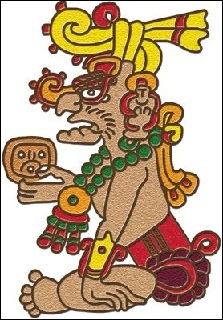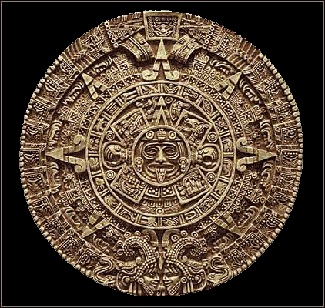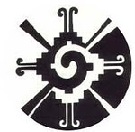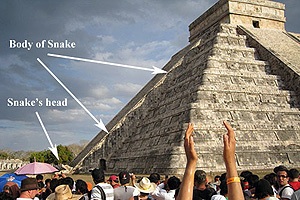
advertisements
... NeptuneCafe presents ...
Mayan Cosmology
and 2012
An explanation of how the Maya came up with 2012 as the zero point of their Long Count calendar system
Having surveyed the plethora of 2012 books, I’ve found that Geoff Stray’s Beyond 2012, Catastrophe or Awakening is one of the most rational guides for detailing the range of predictions. He discusses mass telepathy, alien contacts, Bible codes, crop circles, end times, Nibiru, and various scientific claims and theories. While his approach is comprehensive, it’s not particularly convincing that 2012 is indeed a pivotal year for humankind. Perhaps it’s because his encyclopedic approach covers too much flakey science and unverifiable paranormal claims.
By far, the best book on this subject is John Jenkins’ Maya Cosmogenesis 2012. Published in 1998, any 2012 specialist writing after this date pays due homage to Jenkins’ scholarly approach. He has researched the Mayan Long Count – the 5,125-year calendar than ends in 2012 – from a variety of academic perspectives, and the only way he could make sense of Mayan culture was by synthesizing his discoveries. In general, academics are highly specialized, but Jenkins blended the latest findings and advances in a variety of fields, including astronomy, archeology, ethnography, iconography, and mythology.
What he found ran counter to what the experts were saying. The paradigm-busting idea that the Mayans were well aware of the grand precession cycle was not acceptable in academic circles, although a few researchers had mentioned it in passing. More to the point, not only were the Mayans aware of precession, their entire cosmology was built on the concept. The reason the Long Count ends on December 21, 2012 is that the Winter Solstice aligns with the Galactic Center on that date. This alignment happens only once every 25, 800 years.
To visualize what the Mayans saw, go out and look at the night sky, and find the Milky Way. Nowadays, we know that the Milky Way is our own galaxy. Our solar system exists on the outer edge of a spiral galaxy, and we are looking at our galaxy sideways, so that we don’t see the spiral shape, but just a band of clustered stars. Looking out toward Gemini or Cancer, the Milky Way thins out because we are looking out into the universe beyond our Milky Way. Looking toward Sagittarius, we see the Milky Way at its thickest, because this is toward the center of our galaxy. It seems to bulge, like an impregnated womb.
This is what the Mayans saw, and they referred to this bulge as the cosmic source of everything, the Womb of All. Coincidentally (!?!), scientists now theorize that the center of our galaxy at 27º Sagittarius contains a massive black hole, and that the entire contents of our Milky Way was created from the material that came spewing out of that black hole.
With so many books on the market about 2012, it’s difficult to get a clear idea about what’s really going on. Everyone seems to be jumping on the bandwagon. Numerous psychics, channelers, astrologers and New Age practitioners of all stripes have chimed in on what 2012 will bring, often with apocalyptic or disaster-oriented messages.


This article is an excerpt from the wide-ranging article "Forecast for 2012" by Michael O'Reilly, which will be published in Dell Horoscope's 2012 Yearbook. For more info, see Dell Horoscope.


When the Mayans built the Great Pyramid of Kukulcan at Chichen Itza, they designed it so that at sunset on the day of the equinox, shadows fall in a way that look like a snake sliding down the pyramid. It represented the triumph of Kukulcan, the winged serpent of the sun, over his brother, Huracan, the jaguar god of the night, from whose name we get the word hurricane.
from Zoe Nature

Visit other NeptuneCafe pages devoted to 2012:
Jenkins has determined that the Long Count was perfected at Izapa, a coastal town near the Mexico-Guatemala border. In tropical latitudes, the Sun passes through the zenith at high noon twice a year. The further south one goes, the larger the interval becomes between the two zenith points. At Izapa, the interval is 105 days between the first zenith point and the second. Or measured from the second to first, it’s 260 days. This is how 260 became the primary sacred cycle of the Mayan calendar. The 260-day cycle at Izapa is centered on the Winter Solstice, which marks the return of the light. It’s the most important day of the year, a sacred day of renewal.
According to Jenkins, the Izapans figured out the rate of precession sometime between 250 BC and 50 BC. They saw that the December Solstice Sun was slowly shifting toward the center of the Galactic Tree, the Womb of All. Over 2000 years ago, they calculated that the Solstice Sun would be at this center in 2012. From that point on, many of their architectural structures, myths, sacred ceremonies and calendar cycles were geared to this future point in time.
The fabulous Pyramid of Kukulcan at Chichen Itza is an example of how the Long Count is encoded in Mayan architecture. All the lines in this pyramid are directed toward astronomical phenomena. Windows in the upper tower point to extreme northern and southern positions of Venus. The corner-to-corner alignment along the base points to the solstice axis. Two other alignments point to the two zenith dates. Tourists gather annually at the spring equinox to see a shadow snake appear around 4 pm, made once a year from the Sun’s light casting a zigzag shadow on the stair steps.
In our day, the Sun’s annual alignment with the Pleiades takes place on May 20, which is one of the two sacred zenith passages at Kukulcan. Due to precession, this is only true in the early 21st century. Jenkins describes the Pyramid of Kukulcan as a precessional star-clock, and the synchronization of the Pleiades with the zenith Sun marks the Zero Point in 2012. The appearance of the shadow snake at Kukulcan in the 21st century is symbolic of the mystical return of Quetzalcoatl, the Plumed Serpent.
From all this, we can take away that something spectacular will be happening in 2012, if we agree that the Mayans had unique insights about humanity’s evolutionary path. Read Jenkins’ book and you will be convinced. Their incredibly sophisticated architecture reveals they knew about precession, although most modern academics won’t go along with that. December 21, 2012 is the key date, and May 20 is also significant. Jenkins doesn’t dabble in predictions, although he makes one notable exception when he notes that May 20, 2012 is not only when the Sun aligns with the Pleiades, but is also a Solar Eclipse. “If we were pressed to make a prediction based on all these scientific facts and archeological clues, we could suggest that Mexico City will be destroyed by a violent earthquake.”
To the Mayans, the cosmic center was not a nebulous region as we see it in the night sky. The exact center was pinpointed by locating where the ecliptic (the Sun’s path around the earth) crosses the Milky Way. The ecliptic and the Milky Way together form a celestial cross, which was known by the Mayans as the Crossroads or the Sacred Tree. The fundamental 260-day cycle used by the Mayans is sacred because it corresponds to the period of human gestation. In the same way, they figured the 26,000 year cycle was a more cosmic gestation period describing our collective unfolding or spiritual evolution as a species.